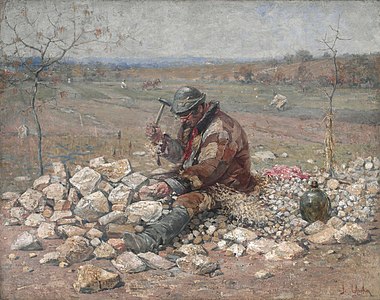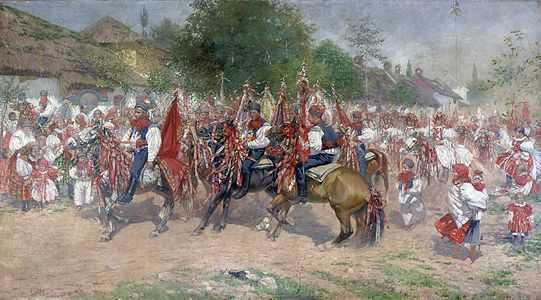Joža Uprka
- Machine translation, like DeepL or Google Translate, is a useful starting point for translations, but translators must revise errors as necessary and confirm that the translation is accurate, rather than simply copy-pasting machine-translated text into the English Wikipedia.
- Do not translate text that appears unreliable or low-quality. If possible, verify the text with references provided in the foreign-language article.
- You must provide copyright attribution in the edit summary accompanying your translation by providing an interlanguage link to the source of your translation. A model attribution edit summary is
Content in this edit is translated from the existing Czech Wikipedia article at [[:cs:Joža Uprka]]; see its history for attribution. - You may also add the template
{{Translated|cs|Joža Uprka}}to the talk page. - For more guidance, see Wikipedia:Translation.

Joža Uprka (26 October 1861, Kněždub – 12 January 1940, Hroznová Lhota) was a Czech painter and graphic artist, whose work combines elements of Impressionism and Art Nouveau to document the folklife of Southern Moravia.
Biography

He was born to a peasant family. His father was an amateur painter, which inspired Joža and his brother, František, to pursue careers in art.[1] After completing his primary education, he enrolled at the Academy of Fine Arts, Prague, where he studied with František Čermák. After Čermák's death, he transferred to the Academy of Fine Arts, Munich, where he was one of the founders of a Czech student organization called "Škréta" (after Karel Škréta), a group that included Alfons Mucha, Antonín Slavíček, Pavol Socháň and Luděk Marold.[2]
In 1888, he returned home and began painting scenes from peasant life. From 1892 to 1893, he was able to study in Paris, thanks to a scholarship and, in 1894, with Mucha's assistance, gave a showing at the Salon. His first major exhibition in Prague came in 1897.[1]
He was married in 1899 and, shortly after, bought a small house in Hroznová Lhota, which he used as a studio. In 1904, it was transformed into a two-story villa, inspired by folk architecture, with a design by Dušan Jurkovič.[2] It soon became a popular meeting place for many notable Czech artists, writers and composers. The following year, however, his wife's mental condition, which was always poor, took a turn for the worse and it was necessary to place her in the mental hospital at Kroměříž. She stayed there until her death in 1959.[2]
After this time, he largely turned away from painting to do etchings. From 1922 to 1937, he lived in a castle in Ilava and maintained a studio in the Slovakian countryside, where he went for inspiration. In 1928, he visited Dubrovnik, where he observed the local customs. His folk paintings received a major showing in Uherské Hradiště at the "Výstava Slovácka 1937". He died of kidney failure three years later, and was returned to his place of birth for burial.[2]
In 2011, a school in Hroznová Lhota was named after him.
Selected paintings
-
 Pilgrimage to the chapel of Saint Anthony
Pilgrimage to the chapel of Saint Anthony
above Blatnice -
 The Stonebreaker
The Stonebreaker -

References
- ^ a b Brief biography @ the Hroznová Lhota website.
- ^ a b c d Joža Uprka: svébytný umělec nebo folklorista? (an original artist and folklorist?) Lidovky (Lidové noviny), [1]
Further reading
- Štěpán Jež and Jakub Obrovský, Joža Uprka : k pátému výročí umělcovy smrti (On the fifth anniversary of his death), Sfinx, 1945
- Jaroslav Kačer, Joža Uprka : výběr z malířského díla (Selection of paintings), exhibition catalog, Moravian Gallery in Brno, 1983
- Petra Karpíšková, Příběh moderního tvůrce. Joža Uprka (1861-1940) (Story of a modern creator), Thesis, University of South Bohemia in České Budějovice, 2007 Online
- František Šantavý and Jaroslav Pelikán, Joža Uprka : Grafické dílo z let 1899–1937 (graphic works), Hodonín, 1981
- Joža Uprka: 1861-1940 : Evropan slováckého venkova (Rural Slovakia), National Gallery, Prague, 2011 ISBN 978-80-7035-482-7
External links


Joža Uprka
- Photograph from the blog "White Carpathians" (probably not copyright-free)
- Joža Uprka. Kožuchy ("Furs", a study of folk costume). Kroměříž, 1920. Text online.
- Joža Uprka - barvy a písně (colors and songs) - video from Česká televize














